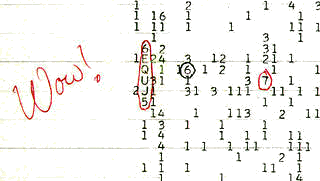Robotic SETI
April 27, 2012
"Have your people call my people," is one common rejoinder for characters on
television situation comedies. In the
search for extraterrestrial intelligence, the first handshake may be between their
robots and our robots. There's also the possibility that this might happen after both intelligent civilizations have become extinct.
SETI, the search for extraterrestrial intelligence, has been conducted on the earth for about half a century. It started in 1960 with
Project Ozma, an attempt by radio astronomer,
Frank Drake, to listen for intelligent radio signals from two nearby stars,
Tau Ceti and
Epsilon Eridani.
Project Ozma used a
radio telescope of the
National Radio Astronomy Observatory (
Green Bank, West Virginia) to search a small
bandwidth around the "
water hole," the 1.420
gigahertz (21
cm wavelength)
emission line of interstellar hydrogen. This was thought to be an obvious place for communications when no standard communications frequencies are known.
Drake used a 26
meter telescope at the Green Bank site to make 150 hours of observations over a four-month period. No intelligent signals were detected, but this inspired other searches, such as
John Krauss' Big Ear at
Ohio State University, famous for the unexplained
Wow! signal (see figure). Today, there's the on-again-off-again search by the
SETI Institute using the
Allen Telescope Array.

The Big Ear WOW! signal, recorded on August 15, 1977.
The time-varying signal intensity, 6EQUJ5, was recorded using a 36 level coding with the characters (space), 1..9, A..Z.
(Via Wikimedia Commons))
Such
radio searches are one-way affairs; that is, we're just listening and hoping that the
extraterrestrials are kind enough to send some very strong radio signals our way. Perhaps the extraterrestrials are not in a talking mood. Aside from the
asymmetry of this scheme, there's the problem that we think that radio is the best means for such extraterrestrial contact.
I'm reminded of the
golden hammer rule; namely, "When all you have is a hammer, everything looks like a nail." Will radio even be used a hundred years from now, or will it have been replaced by something much better? A hundred years from now our descendants might be comparing their technology to radio in the same way that we compare radio to
smoke signals.
Other communication schemes have been proposed. The
laser, of course, is one of these, and one of its
inventors,
Charles Townes, proposed
optical SETI as early as 1983.[2] Even earlier than that, in 1960,
Ronald N. Bracewell proposed sending
physical probes in search of extraterrestrial life.[3]

A robot almost everyone can relate to.
Would an E.T. of today phone home on an Android phone?
There are about 300 million users of Android devices.
(Via Wikimedia Commons))
Several aspects of a successful robotic SETI program are covered in an article by
Penn State professor of
electrical engineering,
John D. Mathews, scheduled to appear in the
Journal of the British Interplanetary Society.[4] Mathews argues for a mission that takes into consideration the
economical realities of
civilizations, realities that he thinks are also shared by extraterrestrials.
Mathews thinks that such probes should start as dual-purposed objects that would be designed to clear debris from our
solar system. I mentioned the dangers that
Earth faces from rogue
asteroids in a
previous article (Asteroid Deflection, April 19, 2012). Such autonomous, self-replicating robots can reproduce from materials found in our solar system to launch into the vicinity of other
stars.[4]
A recent
numerical simulation of exploration by such SETI robots gives some interesting insights into the probability of making contact.[5] The model assumes that a probe will have a lifetime of 50 million years, and there's a contact window of about a million years. If there were between a hundred and a thousand civilizations doing robotic probing, then we would have heard from one of these if they were within a thousand
parsecs of the Earth. The extent of the
Milky Way Galaxy is about 35,000 parsecs.
References:
- Early SETI: Project Ozma, Arecibo Message, SETI Institute Web Site.
- C. H. Townes, "At what wavelengths should we search for signals from extraterrestrial intelligence?" Proc. Natl. Acad. Sci., vol. 80, no. 4 (February 1, 1983), pp. 1147-1151.
- R. N. Bracewell, "Communications from Superior Galactic Communities," Nature, vol. 186, no. 4726 (May 28, 1960), pp. 670-671 (paywalled PDF with no free abstract).
- Andrea Elyse Messer, "Finding ET may require giant robotic leap," Penn State University Press Release, April 18, 2012.
- Carlos Cotta and Álvaro Morales, "A Computational Analysis of Galactic Exploration with Space Probes: Implications for the Fermi Paradox," arXiv Preprint Server, July, 2, 2009.
Permanent Link to this article
Linked Keywords: Television situation comedy; search for extraterrestrial intelligence; robot; Project Ozma; Frank Drake; Tau Ceti; Epsilon Eridani; radio telescope; National Radio Astronomy Observatory; Green Bank, West Virginia; bandwidth; water hole; gigahertz; centimeter; cm; wavelength; emission line of interstellar hydrogen; meter; John D. Krauss; Big Ear; Ohio State University; Wow! signal; SETI Institute; Allen Telescope Array; Wikimedia Commons; radio; extraterrestrial; asymmetry; law of the instrument; golden hammer rule; smoke signal; laser; inventor; Charles Townes; optical SETI; Ronald N. Bracewell; Bracewell probe; physical probe; E.T. the Extra-Terrestrial; E.T.; Android; Pennsylvania State University; Penn State; professor; electrical engineering; John D. Mathews; Journal of the British Interplanetary Society; economics; civilization; solar system; Earth; asteroid; star; computer simulation; numerical simulation; parsec; Milky Way Galaxy.